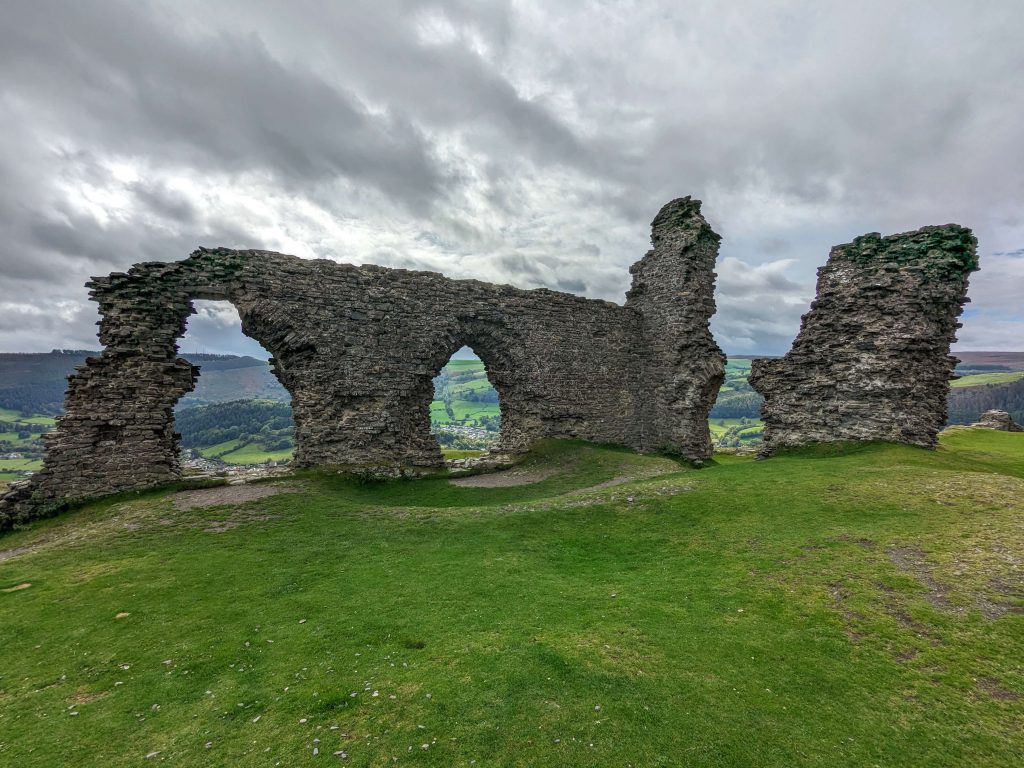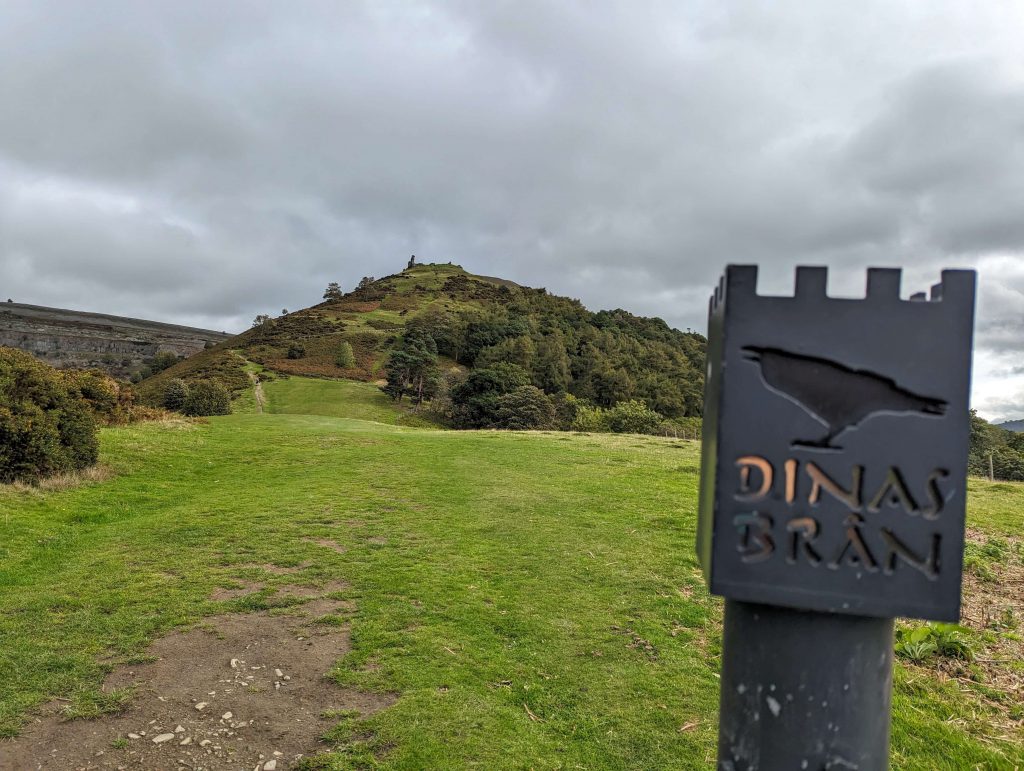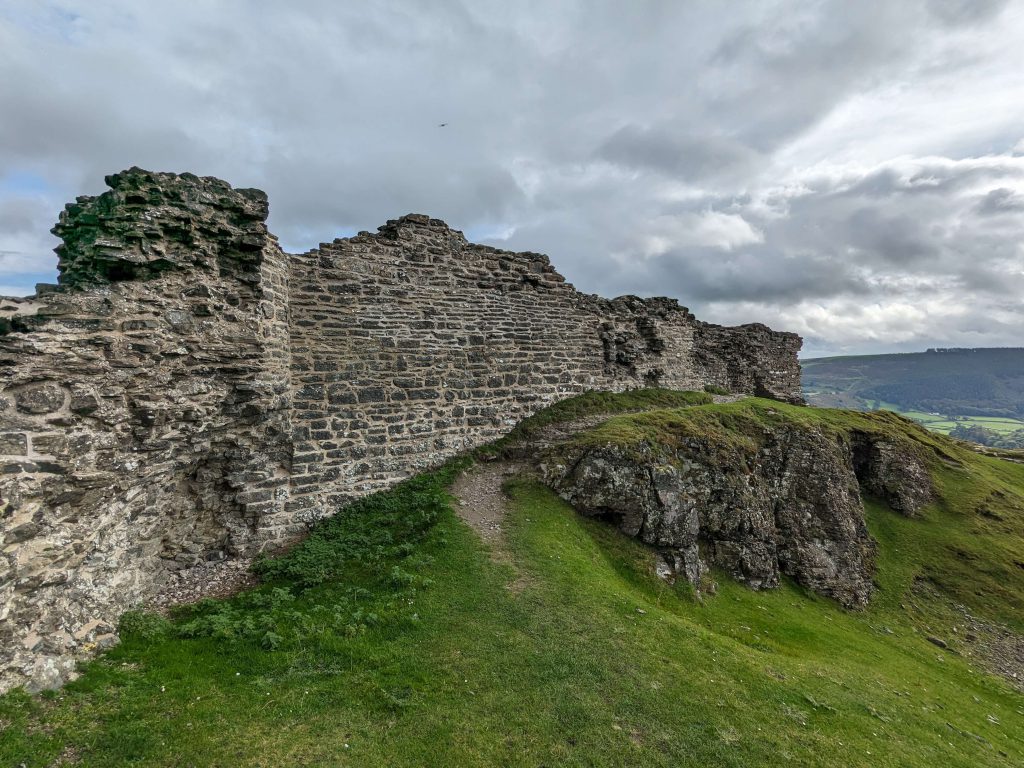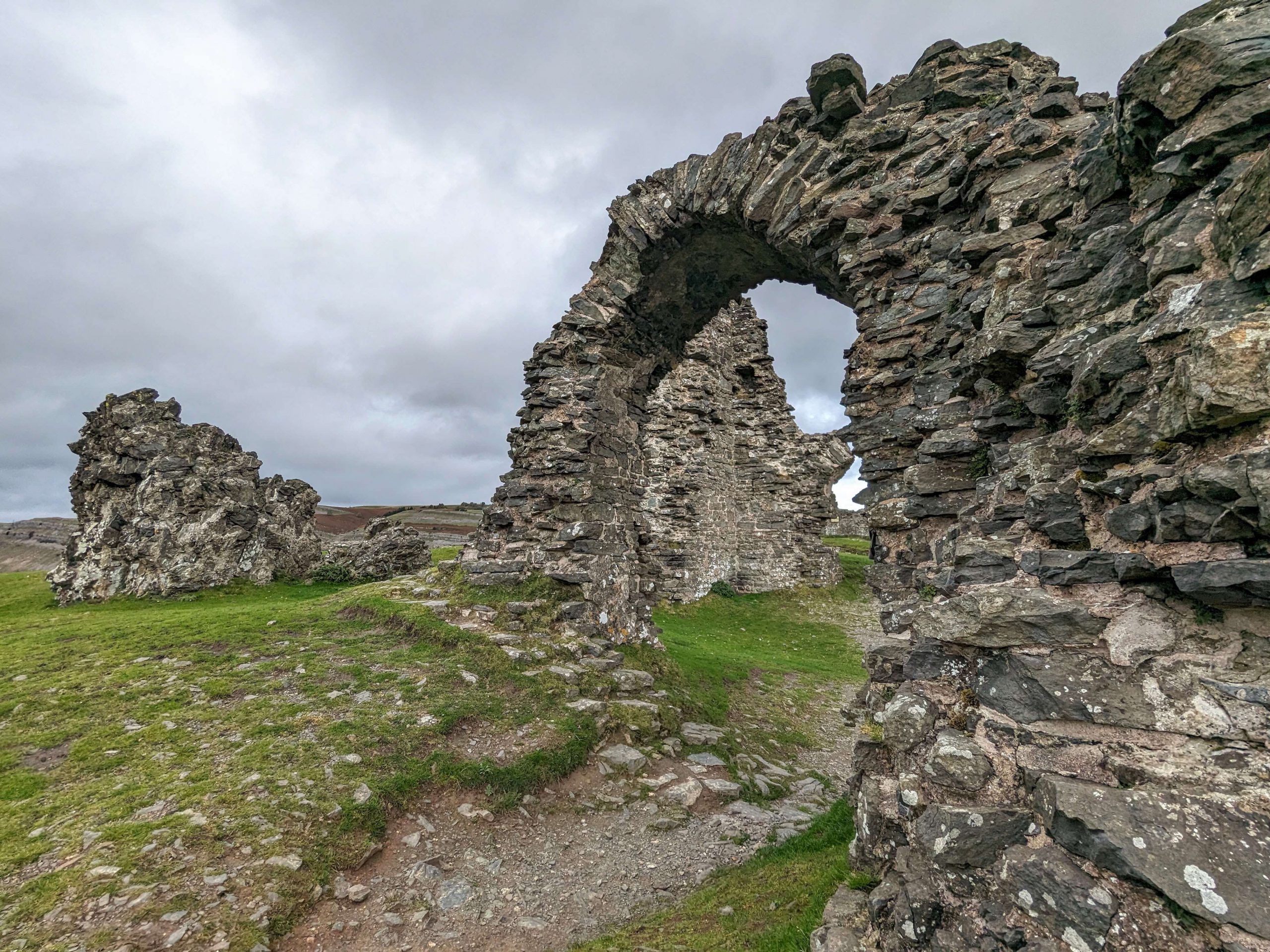The romantic ruins of Castell Dinas Bran sit high up on a craggy hilltop overlooking the delightful Welsh town of Llangollen. The first structures on the site date back to the iron age but the striking ruins that still stand were built by a prince of Powys in the mid 13th century. Castell Dinas Bran, also known as the “Crow’s Fortress” has a number of intriguing myths and legends attached to it which we will explore.
| Built | 13th Century |
| Type | Medieval Welsh Castle |
| Condition | Ruinous – Major Stonework Intact |
| Ownership | Denbighshire Council |
| Access | Public – Admission Free |
| Postcode | LL20 8DU |
Click here to watch our video exploring Castell Dinas Bran and discover its history
Iron Age
In approximately 600 BC, during the British Iron Age, the Celtic tribe known as the Ordovices constructed a substantial hillfort atop the future site of Dinas Brân. Encircled by an earthen rampart, likely accompanied by a wooden palisade, the fort contained a cluster of roundhouses. A strategically dug extra-deep ditch enhanced defence along the milder slopes on the southern side of the hill. This hillfort was among several formidable strongholds controlled by the Ordovices in the northern region of Wales.
Legend has it that during the 8th century the site was occupied by Elisedd ap Gwylog, possibly an ancestor of the princes of Powys. It is thought that the same Eliseg gave his name to an ancient pillar that stands just north of Valle Crucis Abbey, near Llangollen. However no archeological evidence has been discovered at Dinas Bran to support Elisedd being there.
Medieval Period
The stone castle ruins we see today are believed to have been built by Gruffydd II ap Madog in the 1260’s, although some believe the castle was built slightly earlier in the 1230’s by Madog’s father, Gruffydd ap Madog, who built the nearby Valle Crucis Abbey.
Gruffydd II ap Madog allied himself with Llywelyn ap Gruffudd, Prince of Wales. Dinas Brân was among the castles under construction subsequent to the signing of the Treaty of Montgomery. This treaty ensured Welsh sovereignty for Llywelyn, shielding the region from English intervention.


In 1270 circa, Gruffydd II died and was succeeded by his four sons. Madoc, the eldest son, held a senior position, yet each of the sons might have had individual quarters at Dinas Brân.
The temporary peace between Llywelyn and King Edward I of England was short-lived, and in 1277, Edward launched an invasion of Wales. Two of Gruffydd’s sons, Madoc and Llywelyn, aligned themselves with Edward’s forces. Edward instructed them to reclaim Dinas Brân, which Madoc no longer controlled. It is possible that the fortress was now under the authority of Gruffydd’s other two sons, Owain and Gruffudd.
Henry de Lacy, Earl of Lincoln, received orders to lead forces from Oswestry to seize Dinas Brân. Upon his arrival, he discovered that the defenders of the castle had deliberately set it ablaze, preventing the English from utilising it, and retreated before de Lacy’s troops arrived. In spite of the fire, it is said the castle surprisingly endured minimal damage and was garrisoned by the English.
Following the Treaty of Aberconwy on 10th November 1277, a brief period of peace ensued between the English and Welsh but the war resumed in 1282. During this period there is no mention of Dinas Bran until Prince Llewellyn died in October 1282 and the war ended. Edward granted the castle to John de Warenne, Earl of Surrey, however he showed no interest in Dinas Bran and chose to build a new castle, Holt Castle, situated on the Welsh–English border by the banks of the River Dee and Dinas Bran was left to fall into ruin.
Description
Dinas Brân’s tenure as an active fortification was remarkably brief, despite its commanding position atop a rugged hill reaching over 700 feet in elevation. The curtain wall enclosed a space approximately 300 feet in length and 130 feet in width. At the eastern extremity, a simple square keep was attached to the curtain wall. Similar to other keeps at the time, entry was facilitated at the first level above the ground floor, accessed by means of a movable wooden ladder.
The castle’s defence was complemented by a substantial rock-cut ditch and counterscarp bank, except for the northern side where steep slopes served as a natural defence. Positioned on the shorter east side, set apart from the courtyard by a rock-cut ditch, stood an elaborate twin-towered gatehouse. Along the midpoint of the elongated south side, a D-shaped tower projected from the courtyard wall, and indications suggest the presence of a hall between this tower and the ditch.


Folklore
The literal translation of Castell Dinas Brân into English is the “Crow’s Castle” Therefore, the straightforward interpretation of the castle’s name is that it refers to a location where crows inhabit and the castle in known in English as “Crow Castle”
Legends intertwine Castell Dinas Brân with the king of Britain featured in the “Mabinogion,” a tale dating back to Arthurian times. The king, named Bran, which translates in Welsh to “crow” ,” met his demise after invading Ireland, but his head was brought back to England and buried at London’s Tower. According to the stories, as long as Bran’s head remained buried, Britain would be protected. This notion may have contributed to the connection with the Tower of London, where real ravens are believed to possess magical powers, ensuring the protection of the kingdom.
However, narratives also recount that King Arthur retrieved Bran’s head, choosing to personally safeguard Britain rather than relying on the mystical power of a buried body part. Additionally, claims suggest that the hillock at Dinas Bran conceals the Holy Grail or a golden harp, and it is believed that fairies inhabit the area.


According to the 12th-century tale “The Romance of Fulk Fitzwarine,” Dinas Bran was once the residence of King Bran. Following Bran’s passing, the castle was left abandoned due to persistent rumours circulated that the castle was haunted by evil spirits. Payn Peveril, a renowned and boastful Norman Knight, sought to dispel these rumours and prove his courage. Determined to spend the night within the castle, Payn, along with 15 knights, faced an unexpected storm that brought forth the malevolent giant Gogmagog, Armed with a deadly mace, Gogmagog was described as a man giant possessed by an evil spirit.
In a daring defence, Payn confronted the giant using his shield and cross, catching Gogmagog off guard. With swift action, Payn stabbed the giant with his sword. As Gogmagog lay dying, he revealed the earlier valiant efforts of King Bran, who had constructed the castle to combat the giant. Despite King Bran’s attempts, he was compelled to flee, allowing the giant to torment the land for many years. The giant disclosed the presence of a great treasure beneath Dinas Bran, including a massive golden ox, but died without disclosing the exact location of this hidden wealth.
Click below to explore Castell Dinas Bran with us

